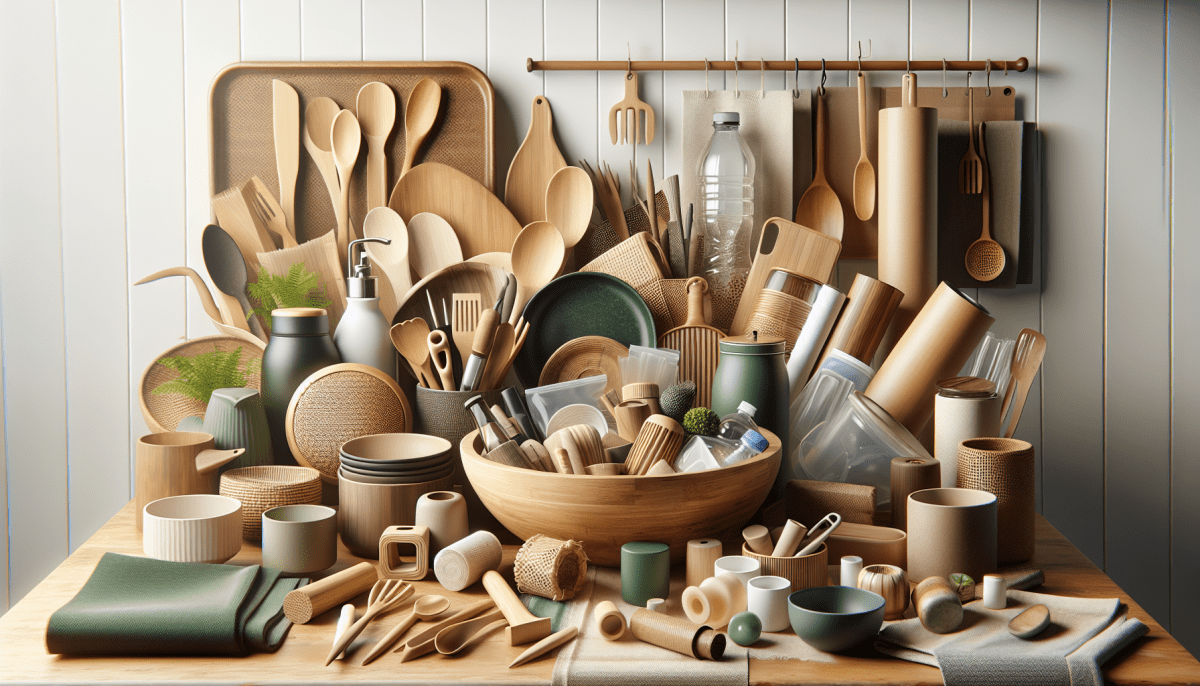Environmental Impact: Assessing the Sustainability of Bamboo and Plastic
When it comes to making sustainable choices, understanding the environmental impact of our decisions is crucial. Bamboo and plastic are two materials that are commonly used in various industries, but their sustainability profiles differ significantly. Let's delve into the environmental impact of both materials and examine which one is more sustainable.
The Sustainability of Bamboo
Bamboo is considered an eco-friendly alternative due to its rapid growth and regeneration ability. It is one of the fastest-growing plants on the planet, with some species growing up to 35 inches per day. This quick growth means it can be harvested and replenished at a much faster rate compared to traditional timber species.
Bamboo also has a low environmental impact during cultivation. It requires no fertilizer and relatively little water compared to other crops, reducing the strain on natural resources. Additionally, bamboo plants have a high carbon absorption capacity, which means they can help mitigate climate change by absorbing more carbon dioxide from the atmosphere compared to other plants.
The use of bamboo in various industries, such as construction and textiles, has gained popularity for its sustainability benefits. Bamboo-based products, such as bamboo flooring and bamboo fabric, have a lower carbon footprint compared to alternatives. Moreover, bamboo has a natural resistance to pests, reducing the need for chemical pesticides.
The Sustainability of Plastic
Plastic, on the other hand, poses significant environmental concerns. It is derived from non-renewable fossil fuels, usually crude oil or natural gas, and requires energy-intensive extraction processes. The extraction and processing of plastic contribute to greenhouse gas emissions and global warming.
Plastic also has a long degradation timeline, with some estimates suggesting it may take hundreds of years to fully decompose. Consequently, it accumulates in landfills and oceans, causing pollution and endangering wildlife. The microplastic particles that result from the breakdown of plastic have been found in various ecosystems, including marine life.
Additionally, plastic production requires significant amounts of water, adding to the strain on already scarce resources. The manufacturing process also involves the use of toxic chemicals, which can have harmful effects on both human health and the environment.
Comparing the Environmental Impact
When assessing the sustainability of bamboo versus plastic, it is evident that bamboo has a more positive environmental impact. Bamboo's rapid growth and regeneration, along with its low water and fertilizer requirements, make it a more sustainable option compared to plastic. Furthermore, bamboo's carbon absorption and natural pest resistance attributes contribute to its eco-friendly profile.
Plastic, on the other hand, is derived from non-renewable resources, has a lengthy decomposition period, and contributes to pollution and wildlife endangerment. Its production process also puts a strain on water resources and involves the use of harmful chemicals.
In conclusion, it is crucial to consider the environmental impact of the materials we use. Choosing bamboo over plastic can significantly contribute to a more sustainable future by reducing carbon emissions, protecting natural resources, and mitigating plastic pollution.
Practical Applications: Comparing the Advantages and Limitations of Bamboo and Plastic
When it comes to choosing materials for various practical applications, such as construction, packaging, or even daily use items, both bamboo and plastic have their own set of advantages and limitations. In this section, we will delve into the practical applications of these materials and compare their merits:
1. Construction:
Bamboo has been used as a construction material for centuries, particularly in regions where it is abundant. Its natural strength, flexibility, and durability make it an attractive option for various construction purposes. Additionally, bamboo is considered a sustainable choice as it grows quickly and requires minimal resources for cultivation.
On the other hand, plastic has gained popularity in construction due to its affordability, high strength-to-weight ratio, and versatility. It can be molded into various shapes and sizes, allowing for intricate designs and customization. However, plastic is derived from non-renewable fossil fuels, and its disposal poses a significant environmental challenge, making it a less sustainable choice compared to bamboo.
2. Packaging:
When it comes to packaging materials, both bamboo and plastic offer their unique benefits. Bamboo packaging has gained attention as an eco-friendly alternative to plastic packaging. It is biodegradable, compostable, and can be produced with minimal carbon emissions. Bamboo packaging can also enhance product aesthetics, as it has a natural and organic appeal.
Plastic packaging, on the other hand, provides excellent durability, ensuring product protection during transit and storage. Plastic materials can be molded into specific shapes and sizes efficiently, allowing for efficient packaging solutions. However, the widespread use of plastic packaging has contributed significantly to plastic waste, causing environmental pollution and harming wildlife.
3. Daily Use Items:
Bamboo and plastic are frequently used in the production of various daily use items, such as utensils, furniture, and household goods.
Bamboo utensils have gained popularity due to their natural beauty, lightweight nature, and resistance to staining and odor absorption. Additionally, bamboo is naturally antimicrobial, making it a hygienic choice for kitchenware.
Plastic utensils, on the other hand, are widely used for their affordability, disposability, and ease of production. However, the disposal of single-use plastic utensils contributes significantly to plastic pollution, leading to environmental damage.
When it comes to furniture and household goods, bamboo has become a popular choice due to its strength, durability, and natural aesthetic appeal. It is often used in the production of flooring, cabinets, and home decor items, providing an eco-friendly alternative to traditional materials.
Plastic furniture and household goods, while cost-effective and readily available, lack the natural beauty and warmth associated with materials like bamboo. Furthermore, plastic items can release harmful chemicals over time, posing health risks.
In conclusion, both bamboo and plastic have their advantages and limitations in various practical applications. Bamboo offers sustainability, natural aesthetics, and inherent strength, making it an attractive choice. Plastic, on the other hand, provides affordability, versatility, and durability but falls short when it comes to environmental sustainability and health concerns. As responsible consumers, it is crucial to consider the long-term impact of our material choices and prioritize sustainable options whenever possible.
Economic Considerations: Is Bamboo a Viable Alternative to Plastic?
When it comes to considering bamboo as an alternative to plastic, economic factors play a crucial role. The economic viability of bamboo products compared to plastic can have a significant influence on consumer behavior and the adoption of sustainable materials. Let's examine some key economic considerations in this comparative analysis.
1. Production Costs
In terms of production costs, bamboo has several advantages over plastic. Bamboo grows abundantly in many regions and requires minimal inputs such as water, pesticides, and fertilizers. This makes bamboo cultivation less resource-intensive and less expensive than conventional plastic manufacturing processes. Moreover, bamboo forests can be harvested sustainably without causing environmental degradation, ensuring a continuous and cost-effective supply of raw material.
On the other hand, plastic manufacturing relies on petrochemicals as the main input, which exposes the industry to price fluctuations and geopolitical risks. Additionally, the extraction and processing of petroleum-based materials contribute to greenhouse gas emissions and environmental pollution, which can negatively impact the overall cost of production.
2. Product Pricing
Bamboo products have seen a surge in popularity due to their biodegradability and eco-friendly image. Consumers increasingly value sustainable options and are often willing to pay a premium for products that align with their green values. This creates an opportunity for businesses to price bamboo products higher, leading to potential profitability.
In contrast, plastic products have dominated the market for decades due to their low cost. However, shifting consumer preferences and growing awareness of plastic's environmental impact have started to affect consumer demand. As regulations around single-use plastics tighten and public sentiment changes, the market dynamics may shift, impacting the pricing strategy of plastic products.
3. Market Demand and Growth Potential
The demand for sustainable products has been steadily increasing as consumers become more eco-conscious. Bamboo, known for its versatility, can be used to create a wide range of products, including clothing, furniture, construction materials, and packaging. This diverse market potential positions bamboo as a viable contender to plastic.
Furthermore, bamboo's renewable nature means that it can be harvested and replanted, ensuring a sustainable supply chain. This makes bamboo products attractive to businesses looking to tap into the growing demand for environmentally friendly alternatives, potentially driving market growth in the long run.
4. Government Regulations and Incentives
Government regulations and policies can greatly impact the economic viability of both bamboo and plastic industries. Many countries have started implementing bans or levies on single-use plastics, creating a challenging market for plastic manufacturers. On the other hand, governments may provide incentives, subsidies, or tax breaks for businesses involved in sustainable practices, boosting the bamboo industry.
Moreover, as governments increasingly prioritize sustainable development goals and environmental conservation, they may introduce regulations and standards that favor the use of bamboo or limit plastic production. These policy shifts can significantly impact the economic landscape and market competitiveness of both materials.
Overall, considering the production costs, product pricing, market demand, and government regulations, bamboo presents itself as a promising and economically viable alternative to plastic. As consumer preferences evolve and sustainability becomes a priority, businesses that embrace bamboo may find themselves at an advantage, both economically and environmentally.


